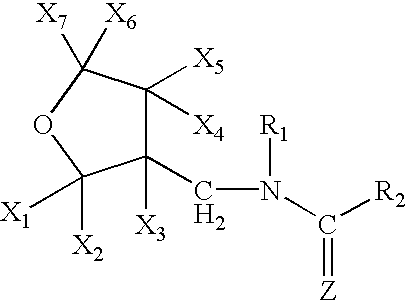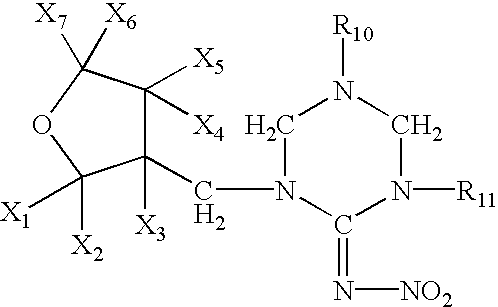High concentration topical insecticide
a topical insecticide, high concentration technology, applied in the field of insecticides, can solve the problems of high undesirable infestation of animals with fleas, ticks, flies and the like, considerable mess, unpleasant smell,
- Summary
- Abstract
- Description
- Claims
- Application Information
AI Technical Summary
Problems solved by technology
Method used
Image
Examples
example 2
Preparation of Insecticide Formulation Containing Dinetofuran, Ethanol and Water
5 g (i.e., 5.6% (weight / weight)) of dinotefuran was dissolved into 100 ml of a mixture comprising 70% ethanol and 30% water. The resulting mixture can be spot applied to companion animals, such as dogs and cats and will kill fleas, ticks and other insects.
example 3
Preparation of Insecticide Formulation Containing Dinetofuran and Phenyl Methanol
15 g (i.e., 12.5% (weight / weight)) of dinotefuran was dissolved into 100 ml of phenyl methanol. The resulting solution can be spot applied to companion animals, such as dogs and cats and will kill fleas, ticks and other insects.
example 4
In Vivo Activity of a Flea Dermal Treatment Against the Cat Flea (Ctenocephalides felis) on Cats
Eighteen cats were separated into three groups each containing 6 cats. Group 1 (6 cats each weighing 9 lbs. or less) remained untreated as Non-Treated Controls. Group 2 (6 cats each over 9 lbs.) were treated with 3.4 ml of the dinotefuran insecticide formulation (5.71% w / w). Group 3 (6 cats each weighing 9 lbs. or less) were treated with 1.5 ml of the dinotefuran insecticide formulation (5.71% w / w).
Approximately 18 hours prior to treatment the cats were infested with 100 cat fleas (Ctenocephalides felis), which were applied to the animal's back. Cats in Groups 2 and 3 were then treated with the indicated volume of insecticide by dispensing the liquid at skin level between the shoulder blades. Flea counts were taken at day 1 (i.e., 24 hours post-treatment), day 8, day 15, day 22 and day 29. Cats were re-infested with 100 fleas on days 7, 14, 21, and 28. To determine the efficacy of the der...
PUM
| Property | Measurement | Unit |
|---|---|---|
| temperature | aaaaa | aaaaa |
| temperature | aaaaa | aaaaa |
| temperature | aaaaa | aaaaa |
Abstract
Description
Claims
Application Information
 Login to View More
Login to View More - R&D
- Intellectual Property
- Life Sciences
- Materials
- Tech Scout
- Unparalleled Data Quality
- Higher Quality Content
- 60% Fewer Hallucinations
Browse by: Latest US Patents, China's latest patents, Technical Efficacy Thesaurus, Application Domain, Technology Topic, Popular Technical Reports.
© 2025 PatSnap. All rights reserved.Legal|Privacy policy|Modern Slavery Act Transparency Statement|Sitemap|About US| Contact US: help@patsnap.com


